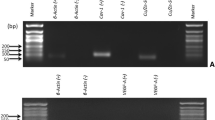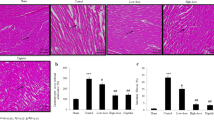Abstract
There is increasing evidence that green tea polyphenols can protect against myocardial damage. Recently, we showed that they bind to cardiac troponin C and alter myofilament Ca2+ sensitivity in cardiac muscle. In the present study, we examined whether green tea extract (GTE) could prevent the progressive remodeling seen in ischemic myocardium and improve cardiac function by modulation of the contractile apparatus utilizing a myocardial infarction (MI) model in the rat involving ligation of the left anterior descending branch. Using this model, severe myocardial injury was found, including altered cardiac performance and the appearance of extensive fibrosis and left ventricular (LV) enlargement. Supplementation with 400 mg/kg/day of GTE for 4, 18, or 46 days had beneficial effects in preventing the hemodynamic changes. Histopathological studies showed that GTE attenuated the progressive remodeling seen after myocardial injury. Echocardiography confirmed that GTE prevented LV enlargement and improved LV performance in post-MI rats. In addition, we showed that GTE supplementation for 18 or 46 days increased the myofilament Ca2+ sensitivity of the ischemic myocardium in post-MI rats. These results validate the novel action of green tea polyphenols in protecting against myocardial damage and enhancing cardiac contractility by modulating myofilament Ca2+ sensitivity in post-MI rats.





Similar content being viewed by others
References
Aleshin A, Ananthakrishnan R, Li Q, Rosario R, Lu Y, Qu W, Song F, Bakr S, Szabolcs M, D'Agati V, Liu R, Homma S, Schmidt AM, Yan SF, Ramasamy R (2008) RAGE modulates myocardial injury consequent to LAD infarction via impact on JNK and STAT signaling in a murine model. Am J Physiol 294:H1823–H1832
Aneja R, Hake PW, Burroughs TJ, Denenberg AG, Wong HR, Zingarelli B (2004) Epigallocatechin, a green tea polyphenol, attenuates myocardial ischemia reperfusion injury in rats. Mol Med 10:55–62
Biesiadecki BJ, Kobayashi T, Walker JS, John Solaro R, de Tombe PP (2007) The troponin C G159D mutation blunts myofilament desensitization induced by troponin I Ser23/24 phosphorylation. Circ Res 100:1486–1493
Chen L, Lee MJ, Li H, Yang CS (1997) Absorption, distribution, elimination of tea polyphenols in rats. Drug Metab Dispos 25:1045–1050
Collins AR, Schnee J, Wang W, Kim S, Fishbein MC, Bruemmer D, Law RE, Nicholas S, Ross RS, Hsueh WA (2004) Osteopontin modulates angiotensin II-induced fibrosis in the intact murine heart. J Am Coll Cardiol 43:1698–1705
Dargis R, Pearlstone JR, Barrette-Ng I, Edwards H, Smillie LB (2002) Single mutation (A162H) in human cardiac troponin I corrects acid pH sensitivity of Ca2+-regulated actomyosin S1 ATPase. J Biol Chem 277:34662–34665
Day SM, Westfall MV, Metzger JM (2007) Tuning cardiac performance in ischemic heart disease and failure by modulating myofilament function. J Mol Med 85:911–921
Day SM, Westfall MV, Fomicheva EV, Hoyer K, Yasuda S, La Cross NC, D'Alecy LG, Ingwall JS, Metzger JM (2006) Histidine button engineered into cardiac troponin I protects the ischemic and failing heart. Nat Med 12:181–189
Dreger H, Lorenz M, Kehrer A, Baumann G, Stangl K, Stangl V (2008) Characteristics of catechin- and theaflavin-mediated cardioprotection. Exp Biol Med (Maywood) 233:427–433
Fishbein MC, Maclean D, Maroko PR (1978) Experimental myocardial infarction in the rat: qualitative and quantitative changes during pathologic evolution. Am J Pathol 90:57–70
Gao XM, Dart AM, Dewar E, Jennings G, Du XJ (2000) Serial echocardiographic assessment of left ventricular dimensions and function after myocardial infarction in mice. Cardiovasc Res 45:330–338
Gordon AM, Homsher E, Regnier M (2000) Regulation of contraction in striated muscle. Physiol Rev 80:853–924
Hao J, Kim CH, Ha TS, Ahn HY (2007) Epigallocatechin-3 gallate prevents cardiac hypertrophy induced by pressure overload in rats. J Vet Sci 8:121–129
Hirai M, Hotta Y, Ishikawa N, Wakida Y, Fukuzawa Y, Isobe F, Nakano A, Chiba T, Kawamura N (2007) Protective effects of EGCg or GCg, a green tea catechin epimer, against postischemic myocardial dysfunction in guinea-pig hearts. Life Sci 80:1020–1032
Hirano R, Momiyama Y, Takahashi R, Taniguchi H, Kondo K, Nakamura H, Ohusuzu F (2002) Comparison of green tea intake in Japanese patients with and without angiographic coronary artery disease. Am J Cardio 90:1150–1153
Hotta Y, Huang L, Muto T, Yajima M, Miyazeki K, Ishikawa N, Fukuzawa Y, Wakida Y, Tushima H, Ando H, Nonogaki T (2006) Positive inotropic effect of purified green tea catechin derivative in guinea pig hearts: the measurements of cellular Ca2+ and nitric oxide release. Eur J Pharmacol 552:123–130
Jochmann N, Baumann G, Stangl V (2008) Green tea and cardiovascular disease: from molecular targets towards human health. Curr Opin Clin Nutr Metab Care 11:758–765
Klocke R, Tian W, Kuhlmann MT, Nikol S (2007) Surgical animal models of heart failure related to coronary heart disease. Cardiovasc Res 74:29–38
Kobayashi T, Solaro RJ (2005) Calcium, thin filaments, and the integrative biology of cardiac contractility. Annu Rev Physiol 67:39–67
Kuriyama S (2008) The relation between green tea consumption and cardiovascular disease as evidenced by epidemiological studies. J Nutr 138:1548S–1553S
Kuriyama S, Shimazu T, Ohmori K, Kikuchi N, Nakaya N, Nishino Y, Tsubono Y, Tsuji I (2006) Green tea consumption and mortality due to cardiovascular disease, cancer, and all causes in Japan: the Ohsaki study. JAMA 296:1255–1265
Li D, Yang C, Chen Y (2008) Identification of a PKCε-dependent regulation of myocardial contraction by epicatechin-3-gallate. Am J Physiol 294:345–353
Li G, Martin AF, Solaro RJ (2001) Localization of regions of troponin I important in deactivation of cardiac myofilaments by acidic pH. J Mol Cell Cardiol 33:1309–1320
Li P, Hofmann PA, Li B, Malhotra A, Cheng W, Sonnenblick EH, Meggs LG, Anversa P (1997) Myocardial infarction alters myofilament calcium sensitivity and mechanical behavior of myocytes. Am J Physiol 272:H360–H370
Liou YM, Kuo SC, Hsieh SR (2008) Differential effects of a green tea-derived polyphenol (−)-epigallocatechin-3-gallate on the acidosis-induced decrease in the Ca2+ sensitivity of cardiac and skeletal muscle. Pflugers Arch 456:787–800
Liou YM, Chang JCH (2004) Differential pH effect on calcium-induced conformational changes of cardiac troponin C complexed with cardiac and fast skeletal isoforms of troponin I and troponin T. J Biochem 136:683–692
Liou YM, Jiang MJ, Wu MC (2000) Altered expression of cardiac myosin isozymes associated with the malignant hyperthermia genotype in swine. Anesthesiology 93:1312–1319
Liu YH, Yang XP, Nass O, Sabbah HN, Peterson E, Carretero OA (1997) Chronic heart failure induced by coronary artery ligation in Lewis inbred rats. Am J Physiol 272:H722–H727
Lorenz M, Hellige N, Rieder P (2008) Positive inotropic effects of epigallocatechin-3-gallate (EGCG) involve activation of Na+/H+ and Na+/Ca2+ exchangers. Eur J Heart Fail 10:439–445
Metzger JM, Westfall MV (2004) Covalent and noncovalent modification of thin filament action: the essential role of troponin in cardiac muscle regulation. Circ Res 94:146–158
Mukamal KJ, Maclure M, Muller JE, Sherwood JB, Mittleman MA (2002) Tea consumption and mortality after acute myocardial infarction. Circulation 105:2476–2481
Solaro RJ, Kumar P, Blanchard EM, Martin AF (1986) Differential effects of pH on calcium activation of myofilaments of adult and perinatal dog hearts. Evidence for developmental differences in thin filament regulation. Circ Res 58:721–729
Peters U, Poole C, Arab L (2001) Does tea affect cardiovascular disease? A meta-analysis. Am J Epidemiol 154:495–503
Pfeffer MA, Pfeffer JM, Fishbein MC, Fletcher PJ, Spadaro J, Kloner RA (1979) Myocardial infarct size and ventricular function in rats. Circ Res 44:503–512
Shioura KM, Geenen DL, Goldspink PH (2007) Assessment of cardiac function with the pressure–volume conductance system following myocardial infarction in mice. Am J Physiol 293:H2870–H2877
Stangl V, Dreger H, Stangl K, Lorenz M (2007) Molecular targets of tea polyphenols in the cardiovascular system. Cardiovasc Res 73:348–358
Stangl V, Lorenz M, Stangl K (2006) The role of tea and tea flavonoids in cardiovascular health. Mol Nutr Food Res 50:218–228
Stephanou A (2004) Role of STAT-1 and STAT-3 in ischaemia/reperfusion injury. J Cell Mol Med 8:519–525
Sumpio BE, Cordova AC, Berke-Schlessel DW, Qin F, Chen QH (2006) Green tea, the “Asian paradox,” and cardiovascular disease. J Am Coll Surg 202:813–825
Suzuki J, Ogawa M, Futamatsu H, Kosuge H, Sagesaka YM, Isobe M (2007) Tea catechins improve left ventricular dysfunction, suppress myocardial inflammation and fibrosis, and alter cytokine expression in rat autoimmune myocarditis. Eur J Heart Fail 9:152–159
Suzuki J, Ogawa M, Maejima Y, Isobe K, Tanaka H, Sagesaka YM, Isobe M (2007) Tea catechins attenuate chronic ventricular remodeling after myocardial ischemia in rats. J Mol Cell Cardiol 42:432–440
Tadano N, Yumoto F, Morimoto S, Nagata K, Tanokura M, Ohtsuki I. Epigallocatechin gallate, a major polyphenol in green tea, binds to cardiac troponin C and desensitizes cardiac muscle contraction to Ca2+. International Symposium Celebrating 40th Anniversary of Troponin Discovery, the 33rd NIPS Conference, Okazaki, Japan, October 25–28, 2005 (Abstract)
Takagawa J, Zhang Y, Wong ML, Sievers RE, Kapasi NK, Wang Y, Yeghiazarians Y, Lee RJ, Grossman W, Springer ML (2007) Myocardial infarct size measurement in the mouse chronic infarction model: comparison of area- and length-based approaches. J Appl Physiol 102:2104–2111
Townsend PA, Scarabelli TM, Pasini E, Gitti G, Menegazzi M, Suzuki H, Knight RA, Latchman DS, Stephanou A (2004) Epigallocatechin-3-gallate inhibits STAT-1 activation and protects cardiac myocytes from ischemia/reperfusion-induced apoptosis. FASEB J 18:1621–1623
Westfall MV, Metzger JM (2007) Single amino acid substitutions define isoform-specific effects of troponin I on myofilament Ca2+ and pH sensitivity. J Mol Cell Cardiol 43:107–118
Westfall MV, Borton AR, Albayya FP, Metzger JM (2002) Myofilament calcium sensitivity and cardiac disease: insights from troponin I isoforms and mutants. Circ Res 91:525–531
Wolfram S (2007) Effects of green tea and EGCG on cardiovascular and metabolic health. J Am Coll Nutr 26:373S–388S
Yang CS, Chen L, Lee MJ, Balentine D, Kuo MC, Schantz SP (1998) Blood and urine levels of tea catechins after ingestion of different amounts of green tea by human volunteers. Cancer Epidemiol Biomarkers Prev 7:351–354
Ytrehus K, Liu Y, Tsuchida A, Miura T, Liu GS, Yang XM, Herbert D, Cohen MV, Downey JM (1994) Rat and rabbit heart infarction: effects of anesthesia, perfusate, risk zone, and method of infarct sizing. Am J Physiol 267:H2383–H2390
Acknowledgments
This work was supported in part by the National Science Council of Taiwan (NSC 95-2320-B-005-005) and cooperative projects between the Taichung Veterans General Hospital and the NCHU (TCVGH-NCHU 967602).
Author information
Authors and Affiliations
Corresponding author
Rights and permissions
About this article
Cite this article
Hsieh, SR., Tsai, DC., Chen, JY. et al. Green tea extract protects rats against myocardial infarction associated with left anterior descending coronary artery ligation. Pflugers Arch - Eur J Physiol 458, 631–642 (2009). https://doi.org/10.1007/s00424-009-0655-1
Received:
Accepted:
Published:
Issue Date:
DOI: https://doi.org/10.1007/s00424-009-0655-1




